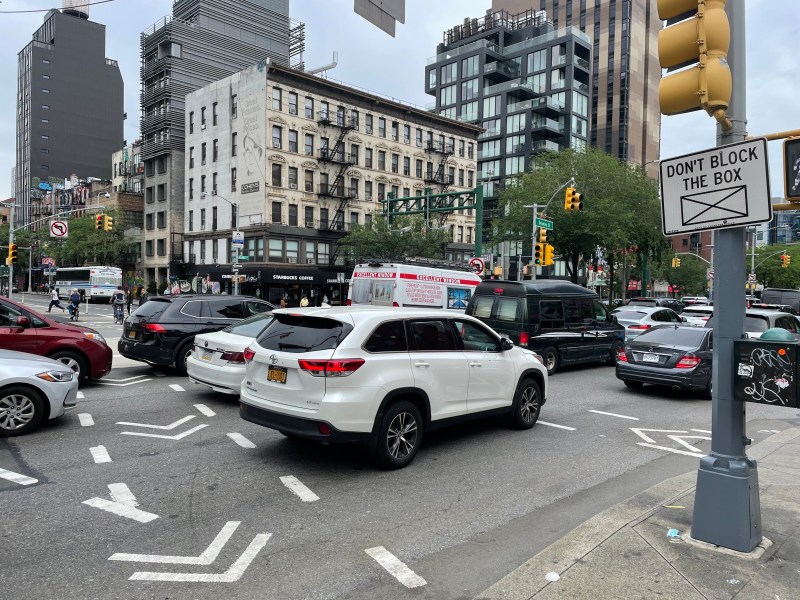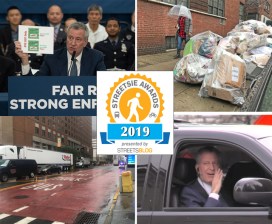Mayor’s Management Report Shows Some Improvements, Lots of Problems Under The Surface

It’s a tale of two managements.
Mayor de Blasio’s final Mayor’s Management Report is full of numbers on the upswing, like protected bike lane miles installed, Select Bus Service route miles in service and Citi Bike rides taken. But behind those numbers are an uptick in road deaths, a drop in regular cyclists and bus speeds that have remained stubbornly slow for years. And, of course, left unmentioned in the report is that the mayor’s failure to manage the streets has led to more cars (which explains the slow buses and road deaths).
On the one hand, de Blasio will have left New York City with a plethora of infrastructure improvements that his predecessor can build on. Even with the coronavirus pandemic ruining the first half of 2020, the de Blasio administration managed to install 21 miles of protected bike lanes in FY2020 (July 1, 2019-June 30, 2020), and 29.2 miles of protected bike lanes in the next fiscal year, which ended on June 30. Citi Bike trips, a huge part of the ongoing bike boom, grew from just under 15 million rides in Fiscal Year 2017 to roughly 23 million in the fiscal year just ended.
The report touted that total SBS bus lane mileage is now roughly 145 miles, up from 38 miles in de Blasio’s first term — but then again, the city has added no SBS bus route mileage due to the end of SBS route additions after the debut of the M14 A and D SBS routes in July 2019.
But, look, the news is mixed, with positive indicators often revealing shades of nuance when examined closer.
For example, the mayor followed through on his promise to reduce the city’s vehicle fleet (that he expanded), culling the size of the on-road vehicle fleet from 25,690 in March, 2019 to 24,581 by the end of July, 2021, a 4.3-percent drop. But the total fleet size was 25,585 when de Blasio took office and promptly launched a 19-percent increase in cars, trucks and other vehicles. So, glass half full there.
There was a mixed bag of results when it came to keeping the streets in working order. On the one hand, the de Blasio administration was able to raise the percentage of streets with a pavement rating of “Good” from 69.8 percent of streets in Fiscal Year 2017 to 73.6 percent in Fiscal Year 2021. On the other hand, the amount of potholes filled in on local roads dropped from 229,160 in Fiscal Year 2017 to 146,622 in Fiscal Year 2021.
Similarly, the amount of lane miles resurfaced across the city dropped from 1,321.2 miles in Fiscal Year 2017 to 918.3 in Fiscal Year 2021.
Both drops were blamed on pandemic work shortages, as the administration wrote that “due to the lack of contract milling, resurfacing operations began using in-house crews for milling work, leaving fewer crews available to perform pothole repairs, in addition to the already limited staff because of the pandemic. The number of lane miles resurfaced in-house dropped to 918, a result of fewer crews working during the PAUSE order plus a lower internal resurfacing goal of 910 lane miles due to budget limitations.”
The MMR also contained the news that the city resolved steadily fewer sewer backup complaints, from 2,649 in Fiscal Year 2017 to 1,983 in Fiscal Year 2021, a decline that residents of southeastern Queens said was a longtime problem that got renewed attention after the drowning deaths from Hurricane Ida. But the mayor told reporters on Monday that the city’s sewer system would have been overwhelmed even without any handicaps, and that the federal infrastructure bill is a possible solution to our problems.
“Even with perfectly functioning sewers, it was going to overwhelm the sewer system,” de Blasio said. “The entire city sewer system is not built for that level of water. So, we have to look in the eye the things that it will take to adjust to the new climate reality. And we’re talking about a huge, huge sum of money and many, many years, but we’ve got to get to work on it, particularly with the help of the federal government with the infrastructure bill.”
The positive numbers are like a Potemkin village of transportation achievement. For all of the SBS lane mileage, buses have actually gotten slower in the de Blasio era, dropping from an average speed of 9.8 miles per hour in January, 2015, to 9.2 miles per hour in August, 2021. Local buses have similarly not budged, from 7.7 miles per hour in January, 2015 to 7.7 miles per hour in August, 2021.
Some changes — like all-door boarding and faster network redesigns — are needed on the MTA level, but the mayor has disappointed many transit advocates.
“Existing SBS routes now need physical upgrades,” said Riders Alliance Director of Communications Danny Pearlstein. “The city also needs to use messaging and other tools to change car culture, especially among city employees with official vehicles, so drivers don’t keep blocking bus lanes and bus riders.”
An increase in bike lane mileage also didn’t seem to increase the amount of people using them. The city’s count of “regular cyclists” fell each year from 828,000 in 2017 to a low of 787,000 in 2019, before a slight rebound to 796,000 in 2020, the last full calendar year with a bike count. DOT spokesman Seth Stein said that the MMR “does not tell the whole story about cycling in our city” because it only reflects the “number of people who bike every month” and not all commuting trips, Citi Bike usage, delivery cyclists or the total number of daily cycling trips.
“We have additional data points we are excited to share with the public soon that highlights how integral biking has become to helping New Yorkers get around our city,” said Stein, with whom we’ll be following up.
All of the bike lane and open street mileage can’t paper over the fact that deaths on the road went up over the past year, marking the second-worst fiscal year in the Vision Zero era. In the fiscal year that ended on June 30, 275 people died in crashes, including 123 pedestrians and 25 cyclists, increases of 15 and 13.6 percent respectively from the previous July 1 to June 30 period. The only worse July-to-June year was Fiscal Year 2014, when a total of 285 people, including 158 pedestrians and 14 cyclists, were killed on city streets (but the first half of that year was the responsibility of Mayor Bloomberg).
For de Blasio, the missing piece in the equation was cops, whose enforcement capabilities he said were crucial in tamping down lawbreaking on the road, though he failed to mention that the NYPD has been AWOL for years, arresting only 13 drivers for failure-to-yield in Fiscal Year 2021, despite 1,979 failure-to-yield collisions that officers responded to.
In other words, 1,966 drivers walked away scot free despite hitting people with their cars after failing to yield.
And the history of NYPD involvement in the traffic enforcement realm isn’t any better. In 2013, the final year of the Bloomberg era, police wrote 1,036,942 moving violation tickets in all categories, including speeding and the most serious violations such as failure to yield, running red lights, and using a cellphone while driving. By 2019, the year before the pandemic, the number dropped to 985,057 for the year.
De Blasio chose to spin those numbers.
“For the six years before COVID, we know that very aggressive enforcement by the NYPD played a crucial role, on failure to yield, on speeding, it was a crucial element of Vision Zero,” he said. “We also know that everything in terms of enforcement got disrupted profoundly by Covid because the NYPD was called to a variety of other crucial tasks, because there was a long period of time where the strength of the department was reduced because of Covid. So, we need to reorient to get us back to the strong levels of enforcement that we had before.”
Bike lanes are built this way – unprotected, even if raised a few inches – on purpose: to facilitate the movement and storage of cars on them.
Can't find free, legal parking? Park in the bike lane! Can't drive down a traffic lane due to illegal parking? Drive in the bike lane! https://t.co/Kd2nOCrlYy— Lucia 😀 ? (@LuciaDLite) September 20, 2021
But bike lanes around the city still turn into parking lots because of a lack of attention to detail or ambition on design, as cycling advocates highlight. One former employee in Janette Sadik-Khan’s DOT lamented the state of the city’s philosophy towards street design as one that hadn’t emphasized keeping cars out of bike lanes at all costs.
“‘NYC is good at street design’ is a vestige of the Janette period when we were trying a lot of new, exciting things,” Bike New York Director of Communications and Advocacy Jon Orcutt recently pointed out. “The follow up, elaboration & degree of *permanence* since has ranged from really weak to non existent, in a time when Uber & then COVID have made cars resurgent.”
“NYC is good at street design” is a vestige of the Janette period when we were trying a lot of new, exciting things. The follow up, elaboration & degree of *permanence* since has ranged from really weak to non existent, in a time when Uber & then COVID have made ? resurgent pic.twitter.com/WTorgWbbHW
— Jon Orcutt (@jonorcutt) September 13, 2021
Looking at a year of the mayor’s management of the streets during the pandemic, New Yorkers noticed that there was no cohesive network of bike lanes, pop-up or otherwise, that were available during the worst of the pandemic or the era when life returned somewhat to normal. They did notice more cars, roughly 140,000 more new cars registered as a result of the pandemic compared to a normal year, as Crain’s reported — and that trend is merely a continuation of the direction of the de Blasio era. Car registrations outpaced population growth in the city between 2010 and 2017, according to the 2019 New York City Mobility Report, the most recent version of the report to be published.
The resultant chaos had some advocates reminding the mayor that he convened an expert panel to head off some predictable transportation outcomes, but a breakaway group of panel members had to tell the world the mayor showed no interest in listening.
“This is the predictable result of Mayor de Blasio not putting people first and not reclaiming a meaningful amount of space from cars on our streets,” said Transportation Alternatives spokesperson Cory Epstein. “Over a year ago, the mayor’s own experts put forward detailed recommendations to combat carmageddon and expand transportation access, yet the de Blasio administration still has not implemented or even acknowledged this plan. Other major cities around the world massively built out their bike lane networks during Covid, but Mayor de Blasio is following an outdated playbook that is too slow, too cautious, and too piecemeal to be impactful citywide. We need our next mayor to commit, at a minimum, to NYC 25×25 and ensure our streets are a pathway to recovery — not maintaining the failed status quo.”
“We have a multifaceted strategy to eliminate 100,000 daily car and truck trips from NYC streets by 2025.” Sounds crazy and unrealistic but sign me up.
— Aaron Naparstek (@Naparstek) September 18, 2021
But for all the ribbon cuttings and miles added for the city, it’s also time for a new management goal specifically around getting cars off the road according to some of the leading voices in the street safety fight.
“Advocacy and policy goals need to be reoriented toward metrics like: Eliminating X cars and trucks, Y motor vehicle trips, and Z vehicles miles traveled,” tweeted “War on Cars” co-host Aaron Naparstek.


